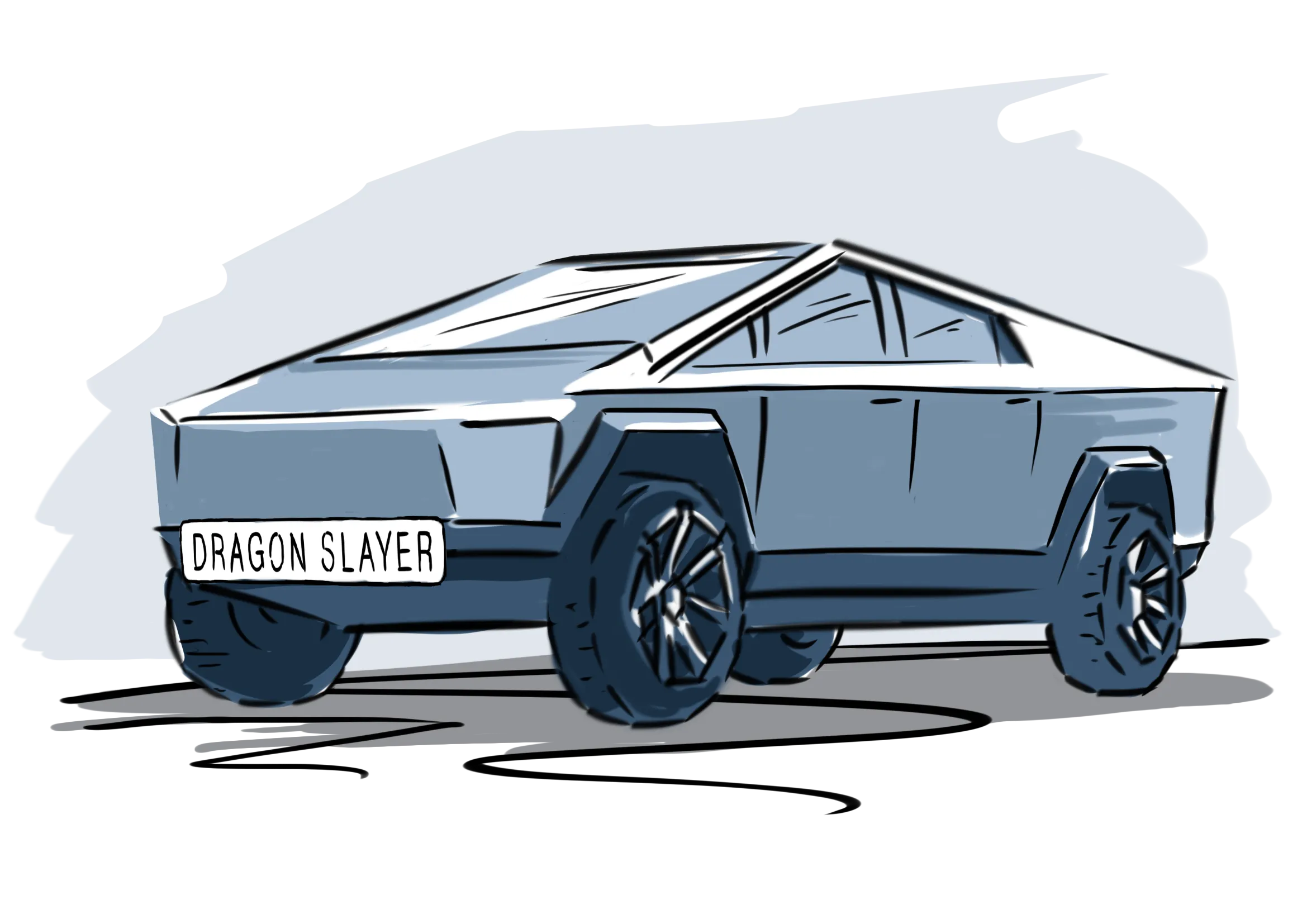Last November, Elon Musk unveiled Tesla’s first pickup truck, dubbed the Cybertruck, with the clear intention to stir up the American truck market. Will he be successful? As experts for go-to-market as well as pricing strategies, we examined the Cybertruck’s sales proposition and came up with 5 questions for Tesla to consider.
Like Nothing Else on the Road: With its controversial styling, high-profile introduction, and impressive pre-order figures, the Tesla Cybertruck has generated an almost unprecedented buzz. At first glance, Elon Musk’s attempt to capture a piece of the lucrative U.S. truck market – by offering competitive towing capacity and a zero to 60 acceleration that is as fast as many sports cars – seems compelling. However, the Cybertruck’s features and price point squarely position it as a luxury vehicle in a truck segment that has historically prioritized utility over glamor. Therefore, this positioning raises three questions worth exploring:
- Can the Cybertruck really compete across the full spectrum of the competitive truck segment?
- Who is the consumer that the Cybertruck is targeting?
- Given that Musk himself says that he does “zero market research”, do we think that Tesla got the pricing of the Cybertruck right?
We will explore these further in the following paragraphs.
Can the Cybertruck compete with big American truck brands?
As a country, US Americans just cannot resist buying pickup trucks. Amidst declining passenger car sales, trucks sales have been prioritized to the point that in April 2020, trucks outsold cars for the first time ever. This comes on the heels of strong first quarter sales for established truck brands, despite COVID-19-related pressures.
How then does Tesla plan on challenging these established brands in a core aspect of their business? Their strategy seems to be something completely different from what America has come to expect from a pickup truck by prioritizing speed, styling, and luxury.
While the Cybertruck looks like a spaceship and, in top-trim form, can sprint from zero to 60 as fast as a Ferrari F8 Tributo, its price tag and capabilities make it less than the ideal choice for many truck buyers. They associate their vehicles mainly with towing and hauling, along with utilitarian applications such as home improvement projects. Although the Cybertruck’s towing capacity is generally competitive, the Big Three (General Motors, Ford, and Fiat Chrysler) offer trucks with similar or better towing and hauling capabilities for substantially less money.
Furthermore, the Cybertruck’s advertised electric range of 250 to 500 miles (EPA est.) will undoubtedly be diminished when under significant load. This shortcoming isn’t a problem for city-dwelling sedans, but nobody wants to tow a boat if it means stopping twice for 30 minutes at a time before getting to the lake. Finally, while the Cybertruck’s styling is memorable, its design appears to make it more cumbersome to load and unload than traditional trucks. Ultimately, we believe that these shortcomings may outweigh the Cybertruck’s durability due to fewer moving parts and high-strength materials. The Cybertruck certainly offers a unique value proposition, but we are not convinced that its features will ultimately entice traditional truck buyers.
That’s OK though, because the Cybertruck was never meant for them in the first place...
If not truck buyers, then who is the Cybertruck built for anyway?
While many truck buyers value function over flash, the segment is too large to pigeonhole all buyers into one category. Pickup truck consumers who prioritize luxury and speed foster demand for performance truck variants such as the highly successful Ford Raptor. For these buyers, the Cybertruck could be a viable alternative. The Raptor found success through a combination of rugged reputation and superior performance, and while the Cybertruck may be associated with a luxury/performance moniker in Tesla, it follows the Raptor’s same basic formula of aggression and speed. However, compared to other performance-oriented trucks, the Cybertruck (particularly the top trim) is faster, more advanced, and certainly more unique than others on the road.
In addition, one could argue that buyers looking for vehicles that are big, fast, and intimidating are currently underserved, as many manufacturers have been ignoring the flamboyant SUV space since the Hummer brand was shuttered. The Raptor is largely in a class of its own in the truck world, and other big, fast, and intimidating options are limited to vehicles like the Mercedes G-Wagon, BMW X5M, or expensive super-SUVs such as the Lamborghini Urus. Despite the success of the Hummer in the early 2000s and the growth of the SUV market in general, no company has focused on building a mass-market SUV or truck as flamboyant as the Cybertruck until now. Fortunately, the all-electric Cybertruck avoids the “dirty, gas-guzzling” stigma that contributed to the Hummer’s demise.
Did Tesla get the Cybertruck’s price right?
Tesla has achieved its meteoric rise in the automotive industry in part by marketing vehicles that almost universally provide “more for less.” The Model 3‘s performance, for example, is faster than a BMW M3 while costing about the same as a 340i. While the Cybertruck’s performance may be a bit more diverse than straight line speed, we can still look at the vehicle through the lens of its three price points to determine whether or not it offers the same undeniable value proposition as other Tesla models:
Base Model: 2WD, $40K, Single-Motor
The base Cybertruck trim level starts at 39,900 US dollars (roughly the same as the average pickup truck sold currently) and is a two-wheel drive with a zero to 60 acceleration time of 6.5 seconds and a towing capacity of 7,500 lbs. This trim level is less capable from a towing perspective than similarly priced trucks, and is not particularly fast by Tesla’s standards. Unlike other basic models, its value proposition and appeal is not readily apparent, beyond serving as an inexpensive entry point. Unless a more value-focused customer is dead set on wanting an electric pickup, we think they are more likely to purchase a traditional truck or even a faster, more inexpensive Tesla over a base Cybertruck. Early sales evidence supports this observation, as of the over 650,000 pre-orders, only an estimated 7.5 percent are from customers opting for the base trim level.
Therefore, we believe that the base trim Cybertruck is too expensive to compete as a bare-bones truck, yet too slow to be a base model Tesla. While low price anchors are often a great way to drive customers towards a vehicle, the practice is not as effective for a vehicle like the Cybertruck, especially when the base model does not provide compelling value. Setting a low price anchor for a luxury vehicle like the Cybertruck makes the more-expensive and higher margin trims seem overpriced, particularly when their styling is identical. Unlike the BMW M3 vs. a standard 3 series, Tesla has shown no inclination to differentiate the basic from the higher end models from a styling perspective.
Mid-Tier Model: 4WD, $50K, Dual-Motor
The intermediate trim level starts at 49,900 US dollars and includes four-wheel drive, 10,000 lbs. of towing capacity, and a zero to 60 time of 4.5 seconds. That is roughly the same as the comparable Model 3, yet quicker than any other truck on the market. While its towing capacity will not set it apart from the competition, the mid-level model is very competitive as a sports truck, given that it has 4WD capabilities and can reach 60 miles per hour faster than the popular Ford F150 Raptor while costing slightly less. This price point makes sense, as truck buyers looking for speed and style get “more for less”, while Tesla buyers receive what they would expect for the money.
Top-Tier Model: 4WD, $70K, Tri-Motor
Finally, the halo trim of the Cybertruck tips the scales at 69,900 US dollars, features a blistering zero to 60 time of 2.9 seconds and a towing capacity that places it best in class. This model is accordingly priced at the top of the segment. However, Tesla’s “more for less” value proposition is readily apparent when comparing the tri-motor Cybertruck to the SUVs that it outperforms, such as the Mercedes G63 AMG (starting at more than 150,000 dollars) or even the Lamborghini Urus (starting at 210,000 dollars). That being said, we wonder whether the over 50 percent discount compared to the Mercedes is a significant selling point for these status conscious consumers. Furthermore, do those same customers really want to be seen in a car with an identical body style as a 40,000-dollar base model?
Figure 1: Tesla Cybertruck Pricing Versus Competitors (price points determined using manufacturer online configurators for comparable vehicles)
Ask the Experts: Could the Cybertruck’s line-up and pricing be improved?
While the line-up has been set and pre-orders have been placed, we feel as though the Cybertruck’s positioning and pricing could still be improved. As such, Tesla might want to reflect on the following five questions, derivative of Simon-Kucher’s project experience and expertise. While it may be too late to fundamentally change the line-up, Tesla could still benefit from potentially implementing some of these improvement levers.
1. Should Tesla have offered the $40k 2WD base model truck?
Based on our longstanding observations of the US pickup market, we believe that Tesla should fully recognize the Cybertruck as a luxury vehicle and not a workman’s truck. As such, we feel Tesla could have been better off not offering the base model in its current form. We do not believe that this variant provides the right value to the workman AND we can see it hindering Tesla’s ability to command premium prices on the higher-tier trims, particularly given that styling is the same across the lineup.
With the 2WD model out of the way, we believe that the $50,000 dual-motor Cybertruck could have served as the base model, as it is still affordable yet aspirational for a premium buyer, with performance that justifies its price tag.
2. Should Tesla have introduced a truck between the dual- and tri-motor models?
If the dual-motor Cybertruck were to serve as the model’s base trim, we question if Tesla could have still filled the gap with a mid-tier model that slots below the tri-motor world-beater. Tesla could have de-tuned the tri-motor truck to do zero to 60 in 3.5 seconds and tow 12,000 lbs., thus creating a clear hierarchy. This mid-range truck could have been priced around 65,000 US dollars, placing it as a price competitor to sporty SUVs such as the BMW X6 and Porsche Cayenne. However, the Tesla variant would have vastly outperformed its luxury competition at this price level, thus maintaining the “more for less” value proposition.
3. Should Tesla have increased the price of their top-tier Cybertruck to monetize the willingness-to-pay of super-SUV buyers?
We view the tri-motor variant as a performance Goliath, and without a low price anchor holding it back, we believe that Tesla could have extracted more value out of their top-tier truck. Following our first two lines of thinking and pricing the halo Cybertruck at 85,000 dollars, Tesla would be left with 3 models, priced at 50,000, 65,000, and 85,000 dollars, all of which provide “more for less” compared to their competitors.
A price point of 85,000 US dollars is historically reserved for high-end luxury or even lower-end exotic vehicles. Still, compared to challengers ranging from the BMW X5M to the Lamborghini Urus, this amount of money is a downright bargain for the level of performance offered by the Cybertruck. In our experience, customers seeking the attention and performance levels offered by the top-tier Cybertruck are more than willing to venture into that pricing territory.
4. Should Tesla tackle the super-premium segment?
If Tesla were to fully position the Cybertruck as a luxury vehicle, then why should they stop at even 85,000 dollars, when their competition is so much more expensive? Our experience leads us to believe that setting a price anchor above the psychological pricing threshold of 100,000 dollars would have the dual effect of solidifying the Cybertruck as an aspirational vehicle, while making the less-expensive trims look like a good deal by comparison.
Tesla could set this price anchor either by building and marketing an even higher-performance model, or adding differentiated features to an existing model and marketing it as “exclusive” by creating scarcity (e.g. a “launch edition” model). Regardless, if Tesla were to go this route, we would suggest building the most expensive models first, so that the public first sees the Cybertruck driven by the best-connected trend setters. After all, 85,000 dollars can seem like a deal when people first notice Cybertruck variants priced at more than 100,000 dollars parked alongside Ferraris outside of Nobu.
5. Should the premium trims of the Cybertruck be sold with built-in community perks?
Tesla, like other high-end automotive manufacturers, has fostered a community of enthusiasts who view their vehicles as a part of their lifestyle and identity. Tesla already is able to monetize their fan base through their referral program, but we wonder if they could capitalize even more by offering additional “community perks” with higher-end trims of the Cybertruck. These perks could include exclusive off-road events in the desert, advanced access to new features via software updates, or even prioritized status on new-vehicle waiting lists. Regardless, by offering their fans experiences and perks that set them apart in the community, Tesla would enhance the value proposition of their highest-tier vehicles.
Summary: A disruptor with unused potential
The Cybertruck is one of the most unique vehicles currently slated for production. While it may not directly appeal to middle-American truck buyers who use their vehicles for work, the pickup truck market is wide enough to include consumers who are drawn to truck ownership for other reasons. The Cybertruck appeals to truck buyers who want a big, stylish, and luxurious status symbol with class-leading speed. We believe that the Cybertruck has all it needs to disrupt the premium truck segment.
The three trim levels offer various value propositions, although we question the current architecture of the line-up. Tesla would have been better off eliminating the 40,000 dollar model, instead making the dual-motor the base trim. In this case, we would then consider raising the price of the current tri-motor model to 85,000 US dollars, and adding a new 65,000 dollar variant to bridge the gap between the standard dual-motor and top-tier. Furthermore, we would suggest that Tesla considers anchoring the price of the Cybertruck at over 100,000 dollars with an exclusive, ultra-premium edition, while introducing special perks for buyers of the most expensive trucks.
As with many unique vehicles, only time will tell what kind of success the Cybertruck will see during its production run. Ultimately, we believe that analysis around the above five questions might help to better monetize the incredible value that the Cybertruck offers to luxury customers. While one may question Elon Musk’s decision to eschew consumer polling in favor of his own marketing instincts, Tesla’s stock is evidence that it is a dangerous proposition to bet against the visionary behind the modern electric car.
Special Thanks to Doug DeMuro for his critique of the Cybertruck’s value proposition that inspired this article!








